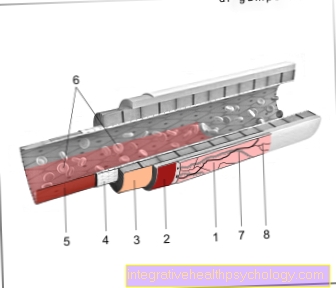Angiolipoma
What is an angiolipoma?
An angiolipoma is a benign tumor that emerged from a fat cell. In addition to fatty tissue, the tumor consists primarily of blood vessels and muscle cells. An angiolipoma is bordered by a delicate capsule from the surrounding tissue. Angiolipomas are characterized by slow growth. The size of an angiolipoma can vary widely, ranging from a few centimeters to the size of a tennis ball. Often the angiolipomas are located directly under the skin and can be felt as soft or firm knots. In contrast to lipomas, which mainly occur in older people over 50 years of age, angiolipomas are particularly common in young men.

Where do angiolipomas occur?
In principle, an angiolipoma can appear anywhere on the body. Angiolipomas are mainly found on the extremities, i.e. arms and legs, with the thighs being particularly often affected. The lump grows in the subcutaneous tissue and forms an easily palpable lump under the skin. The nodules occur either singly or multiple times, in most cases several angiolipomas appear at the same time. Angiolipomas can also occur on the trunk (often on the abdomen or flank) and around the face. Angiolipomas are less common on the hands or feet.
therapy
Angiolipoma does not necessarily have to be treated. However, if the tumor causes discomfort or is perceived as annoying by the person concerned, there is the option of surgical removal. The angiolipoma and the capsule in which it is enclosed are cut out of the subcutaneous fatty tissue.
Before the operation, the doctor explains the procedure and possible risks of the operation to the patient. Then the preparations for the operation begin. This is a small procedure that is usually done quickly. The doctor will inject a local anesthetic that will numb the skin locally. He then cuts open the skin over the angiolipoma and pushes the tumor out. Then the wound is sutured with a few stitches and covered with a bandage.
When does an angiolipoma need to be surgically removed?
An angiolipoma must be removed if it causes pain or other discomfort. Due to the strong blood flow to the angiolipoma, pain occurs in most cases. In addition, the tumor can form in an unfavorable position and displace or narrow other structures. The result is a feeling of pressure or pain. If the angiolipoma grows near a nerve, tingling or numbness is common. In addition, some patients find the tumor aesthetically uncomfortable. In such cases, it makes sense to remove the angiolipoma.
Read more on the subject at: When should a lipoma be removed?
forecast
The prognosis for angiolipoma is good. In most cases, the angiolipoma can be easily cut out of the skin and there are no complications. However, after removal, an angiolipoma often forms again in the same place.
Can an angiolipoma become cancerous?
Usually, angiolipoma has a very low risk of degeneration. This means that the chances that an angiolipoma will develop into a malignant angioliposarcoma are low. Nevertheless, patients are recommended to have their angiolipoma checked regularly by a doctor.
These are the symptoms you can tell you have an angiolipoma
An angiolipoma can be seen as a solid bump that lies directly under the skin. Normally the nodes can be moved easily and can be clearly separated from the surrounding tissue. Due to their slow growth, angiolipomas are not noticeable for a long time, but the fatty growths cause pain at some point. The pain is tender, which means that it gets worse under pressure. Because of this, patients often feel pain when moving or touching the affected areas. But angiolipomas can cause pain even without external influence.
The other symptoms depend on where the angiolipoma grows. If there are nerve tracts in the vicinity of the tumor that are displaced by the growth, skin sensitivity disorders, tingling or numbness may occur. Very large angiolipomas can also be visually disturbing for those affected.
Read more on the subject at: Symptoms of a lipoma
Pain
An angiolipoma is permeated by numerous blood vessels, which are often thrombosed. This means that small blood clots have formed inside the vessels that block the passage. This impedes the flow of blood and leads to an insufficient supply of the structures within the tumor. As a result, the angiolipoma often causes pain or a feeling of tension. In addition, pain can occur when the surrounding tissue is pressed or displaced by the growth.
Read more on the subject at: Lipoma pain - when do you need to remove it?
causes
The reason why angiolipomas develop is not yet known. It is believed that some people have a genetic make-up that encourages the growth of these benign tumors. Certain metabolic disorders such as hyperlipidemia (high blood lipid levels) or diabetes mellitus (high blood sugar levels) may have an influence on the development of angiolipomas. However, there is no scientific proof of this.
diagnosis
If you feel a lump under the skin, you should see a doctor, preferably a dermatologist or surgeon, as soon as possible. The doctor assesses the lump by palpation. Angiolipomas are sharply demarcated growths that are located just under the skin. The consistency can be soft or - if it contains a higher proportion of connective tissue - also coarse. One criterion for the benign nature of an angiolipoma is its mobility: Angiolipomas are very easy to move in relation to the surrounding tissue.
Poor mobility, on the other hand, indicates invasive growth in the surrounding structures and thus a malignant tumor. Using an ultrasound examination (sonography), the doctor can further assess the angiolipoma, measure the size and estimate the extent of the tumor. In order to be able to reliably differentiate an angiolipoma from a lipoma, an MRI is made for the final diagnosis.
How can you tell the difference between an angiolipoma and a lipoma?
An angiolipoma is a special type of lipoma. A lipoma is a swelling of the tissue that is caused by the formation of new fat tissue. The angiolipoma, on the other hand, is much more vascularized, which means it contains more blood vessels than a lipoma. With the help of a magnetic resonance scan (MRI), the doctor can prove whether the tumor is a lipoma or an angiolipoma. In the MRI image, lipomas show the same signal intensity as the (subcutaneous) fat tissue located under the skin. In contrast, angiolipomas can be recognized by the numerous vessels within the fat structure.
Read more on the subject at: Lipoma
More interesting information
Further information on this topic can be found at:
- Treatment of a lipoma
- Remove lipoma
- Pain from a lipoma
- Causes of a lipoma
A list of all topics related to dermatology that we have already published can be found under: Dermatology A-Z





























